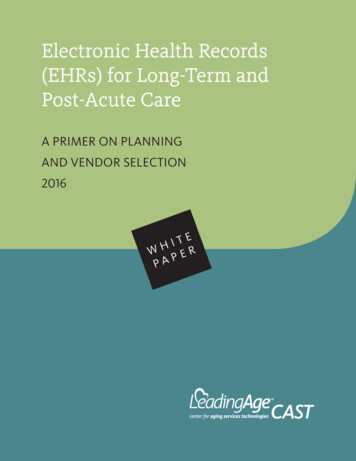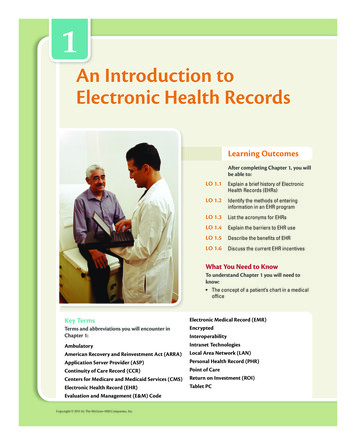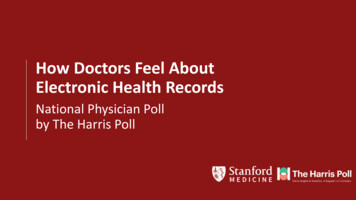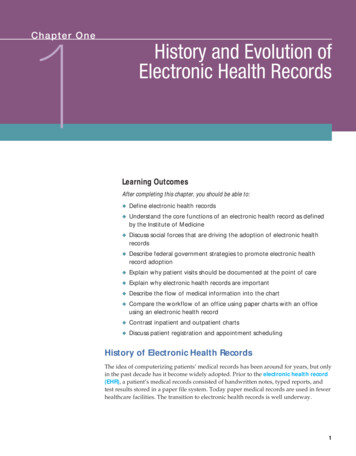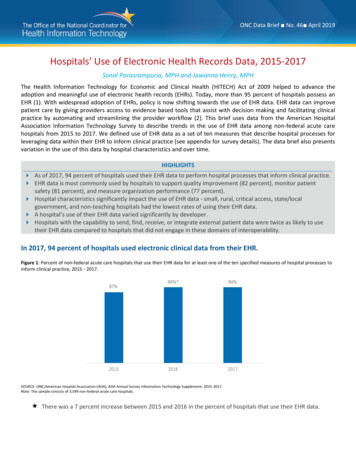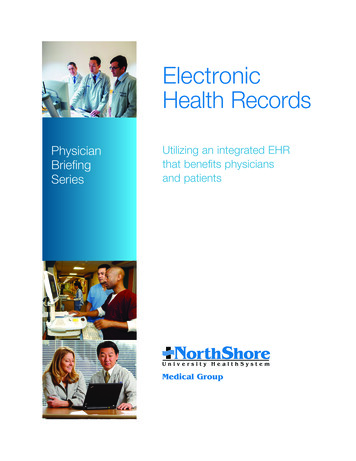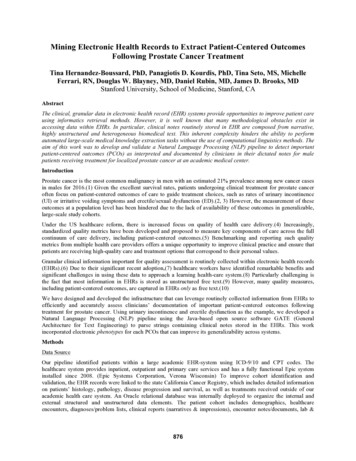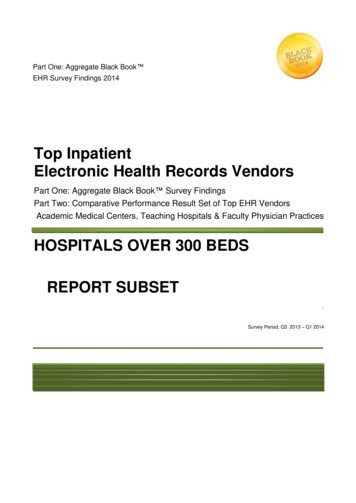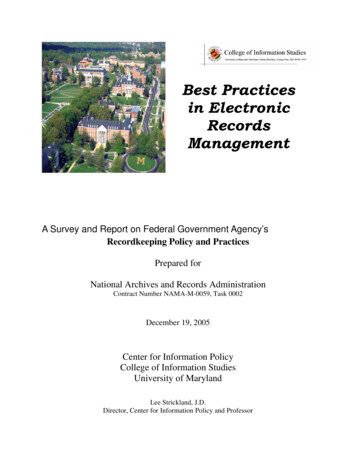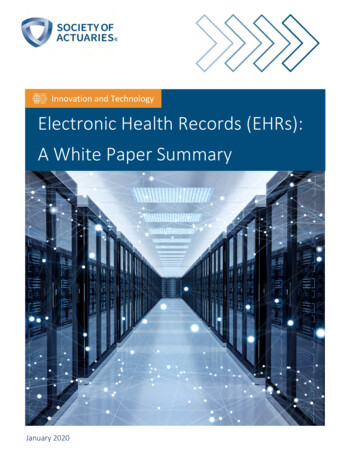
Transcription
Innovation and TechnologyElectronic Health Records (EHRs):A White Paper SummaryJanuary 2020
2Electronic Health Records (EHRs):A White Paper SummaryThe Coming Seismic Shift in Healthcare Data AccessAUTHORJames Timmins, MBAHealthcare ConsultantSociety of ActuariesCaveat and DisclaimerThe opinions expressed and conclusions reached by the authors are their own and do not represent any official position or opinion of the Society ofActuaries or its members. The Society of Actuaries makes no representation or warranty to the accuracy of the informationCopyright 2020 by the Society of Actuaries. All rights reserved.Copyright 2020 Society of Actuaries
3CONTENTSAcknowledgements . 4Section 1: Background and Scope. 51.1 BACKGROUND. 51.2 SCOPE . 5Section 2: EHRs – Definition and Exchange Issues. 72.1 WHAT ARE ELECTRONIC HEALTH RECORDS, OR EHRS, AND WHAT IS THEIR CURRENT STATE INPRACTICE? . 72.2 WHAT ARE THE VARIOUS TYPES OF EHRS THAT ARE AVAILABLE? . 92.3 HOW IS EXCHANGING HEALTH INFO DONE IN PRACTICE? . 102.4 WHAT DIFFICULTIES EXIST WITH AGGREGATING DATA (DUE TO VENDORS/PROVIDERS HAVINGDIFFERENT SYSTEMS)? . 112.5 CAN EHR INTEROPERABILITY MEET HEALTH INSURANCE PORTABILITY AND ACCOUNTABILITYACT (HIPAA) REQUIREMENTS?. 122.6 HOW DO EHR SYSTEMS DEAL WITH HIGHLY CONFIDENTIAL – I.E., PSYCHOLOGICAL/PSYCHIATRIC– INFORMATION? . 122.7 WHAT ABOUT QUANTIFIED SELF DATA – ARE APPLICATION PROGRAMMING INTERFACE (API)APPS USABLE? . 13Section 3: Impact of EHRs on Insurance. 143.1 HOW HAVE EHRS BEEN IMPACTING THE UNDERWRITING PROCESS? . 143.2 WHAT PROTECTIVE VALUE IS BEING PROVIDED FROM EHRS? . 143.3 WHAT ARE EHR’S BENEFIT/PROTECTIVE VALUE INSTEAD OF - OR WITH – ATTENDING PHYSICIANSTATEMENTS (APSS)? . 143.4 WHAT ARE THE DIFFICULTIES WITH MEASURING EHR IMPACT ON EMERGING EXPERIENCE? . 143.5 HOW ARE EHRS AFFECTING OTHER PARTS OF THE INSURANCE BUSINESS? . 14Section 4: Future Status of EHRs . 164.1 WHAT OBSERVATIONS CAN BE MADE ABOUT HOW EHRS AND SHARING OF DATA MAY GO INTHE FUTURE – AND WHEN?. 164.2 WHAT WILL BE THE COSTS OF ACCESSING EHR DATA? . 164.3 WHAT ARE SOME CASE STUDIES THAT RAISE ISSUES AND/OR BENEFITS OF EHRIMPLEMENTATION?. 164.4 WHEN WILL ACCESS TO EHRS THROUGH APIS BE WIDELY AVAILABLE? . 184.5 WHAT IS THE STATUS OF ACTUARIAL EVALUATION & IMPLEMENTATION OF EHR DATA FORINSURANCE PURPOSES? . 184.6 WHAT IS THE ULTIMATE POTENTIAL FOR EHRS FOR THE INSURANCE BUSINESS FROM ANACTUARIAL PERSPECTIVE? . 194.7 WHO APPEAR TO BE KEY OPINION LEADERS IN THE EHR FIELD? . 194.8 WHAT IS THE SUMMARY CONCLUSION ON THE IMPACT OF EHRS FOR THE ACTUARIALPROFESSION? . 19Endnotes . 21Appendix A: Incorporating Wearables into EHRs: Some Pioneering Institutions . 22About The Society of Actuaries . 23Copyright 2020 Society of Actuaries
4Electronic Health Records (EHRs):A White Paper SummaryThe Coming Seismic Shift in Healthcare Data AccessAcknowledgementsThe author wishes to thank the Society of Actuaries and the Actuarial Innovation & Technology Program SteeringCommittee for sponsoring this paper, as well as the members of the Project Oversight Group for their assistance inpreparing this paper. The Project Oversight Group is comprised of Yair Babad, Jenna Fariss, Jason Hong, Mark Ma,Haofeng Yu, and Zhen Yuan. In addition, the author gratefully acknowledges the assistance of Korrel Crawford,Mervyn Kopinsky, and Dale Hall from the Society of Actuaries, who provided much appreciated leadership andcoordination.Copyright 2020 Society of Actuaries
5Section 1: Background and Scope1.1 BACKGROUNDElectronic Health Records, or EHRs, are a major worldwide initiative to eliminate paper recordings – includingAttending Physician Statements (APSs) – of an individual’s medical history and current treatment. The movementhas the potential for transparent sharing, due to interoperability, thus minimizing duplication of data within andbetween holders of medical data; better use of medical history from all sources for medical decisions; minimizationof medical errors; and reduction of total operational costs. However EHRs, while being a dream for decades, haveonly seen rapid adoption by providers in the United States over the past 10 years, driven by society’s adoption ofdigital technology and legislation associated with the Affordable Care Act (ACA). EHRs are generated by softwarefrom a vendor, or paper records are converted by healthcare providers into PDF format.Tens of billions of dollars have been spent by the private and public sectors to fulfill the mandate of convertingpaper recordkeeping into fully digital records, and especially the ability to transfer records, or interoperability. Atpresent, a requirement for 100% patient access exists for 2020. Tremendous angst remains among providers as thegovernment deadlines approach. Providers and vendors are seeking an extension, and roughly half of executivesare unaware of the current deadlines (Accenture survey, 2019)(1).Due to the enormous opportunity that easy electronic access offers the actuarial profession, the SOA hascommissioned this white paper to conduct a scoping evaluation of the status of EHRs, consider the impact on theinsurance industry, forecast when full access may occur, and consider the effects of ‘Big Data.’1.2 SCOPEThe goals of this white paper are listed below, and will be covered in order. What are Electronic Health Records, or EHRs, and what is their current state in practice? What are the various types of EHRs that are available? How is exchanging health information done in practice? What difficulties exist with aggregating the data (due to vendors/providers having different systems)? Can EHR interoperability meet Health Insurance Portability and Accountability Act (HIPAA) requirements? How do EHR systems deal with highly confidential – i.e. psychological/psychiatric – information? What about Quantified Self data – are Application Programming Interface (API) apps usable? How have EHRs been impacting the underwriting process? What protective value is being provided from EHRs? What benefit/protective value is there for EHRs instead of - or with - Attending Physician Statements? Briefly, what are the difficulties with measuring EHR impact on emerging experience? How are EHRs affecting other parts of the insurance business? What observations can be made as to where EHRs and the sharing of data may go in the future – andwhen? What will be the costs of accessing EHR data? What are some case studies that raise issues and/or benefits of EHR implementation?Copyright 2020 Society of Actuaries
6 When will access to EHRs through APIs be widely available? What is the background of actuarial evaluation and implementation of EHR data for insurance purposes? What is the ultimate potential for EHRs for the insurance business from an actuarial perspective? Who appear to be Key Opinion Leaders in the EHR field? What is the summary conclusion on impacts of EHRs for the actuarial profession?Copyright 2020 Society of Actuaries
7Section 2: EHRs – Definition and Exchange Issues2.1 WHAT ARE ELECTRONIC HEALTH RECORDS, OR EHRS, AND WHAT IS THEIR CURRENT STATE INPRACTICE?Electronic Health Records (EHRs, sometimes referred to more narrowly as EMRs for Electronic Medical Records) aredigitized documents of health records of individuals. EHRs include electronically created Attending PhysicianStatements (APSs). An EHR should “make (medical) information available instantly and securely to authorized users”(2). These records are developed directly within existing provider computer systems, within software from vendors,or on paper or other media followed by electronic conversion. At this time, the bulk of earlier paper records havebeen converted to digital records, and are less relevant with the passage of time. EHRs are governed by a strictgovernment privacy law, the Health Insurance Portability and Accountability Act (HIPAA) – which has importantimplications for actuarial access.Examples of raw data that feed into EHRs are shown below ( 2020 RGA. All rights reserved):In 2009, the federal government mandated that EHRs and systems must be installed by large healthcare providers ina way that allows free and complete access by patients by 2020. This is important, as it sidesteps issues of‘ownership’ of EHRs where – except for in New Hampshire – patients do not themselves clearly own their EHR data.Copyright 2020 Society of Actuaries
8(source: www.healthpopuli.com)The Veterans Administration’s healthcare system, managed by Cerner of Kansas City, is targeted for completion ofthis goal by March 31, 2020 (3). Broad adoption remains controversial in terms of timing. Specifically, the 21stCentury Cures Act states clearly what stakeholders need to accomplish to achieve the ultimate goal of EHR utility:“enable the secure exchange of electronic health information without special effort on the part of the user;[provide] complete access, exchange, and authorized use of electronic health information; and [has] no informationblocking.”It is worth noting that, internationally, Cerner is also the leading EHR vendor (chart below); however, only 12% oftheir revenue is earned outside the United States, and mostly in Canada. Oddly, they do not interface with ICD-10(World Health Organization) disease classifications and data.Outside North America, no vendor has more than 8% market share, indicating an even more fragmented EHRimplementation. However, governments are active and approaching EHRs from a legislative perspective. The EUhas internal initiatives for setting up a template format for EHRs (4). In Israel, data from pre-birth to death ismaintained electronically, complemented by 100,000 Israeli genomic files where all medical records shall be underthe same format and usage language (Dr. Yair Babad, personal communication).Copyright 2020 Society of Actuaries
9Source link: deavours/The online publication EHR in Practice provides online tools to compare and contrast current EHR players, at thefollowing dor-directory-8.html2.2 WHAT ARE THE VARIOUS TYPES OF EHRS THAT ARE AVAILABLE?All-digital EHRs – generated in a structured format by contracted software leaders Epic Systems (Madison) or Cerner– have been steadily incorporated into major healthcare providers over the past 10 years at the cost of billions ofdollars. Other lesser-known EHR vendors are also active, along with in-house custom EHR systems. It is importantto note, however, that there is presently no ‘universal format’ for a person’s EHR, which has implications for ease ofuse for actuaries.For earlier and/or contemporaneous paper-based records, conversion into searchable PDF format continues, butappears to be fading especially at larger providers. Smaller providers – especially in the psychiatric area – arebehind in achieving fully electronic conversions.While not widely referenced, a group in Australia is evaluating speech- or video-based EHR possibilities (e.g., MP3 orMP4 formats) (5).The following figures show current types of data that are eligible for incorporation into EHRs - increasingly as vendorsoftware-driven EHRs.Copyright 2020 Society of Actuaries
10Discrete data for EHRs are factual, verified numerical medical information that can be categorized, such as a testresult, whereas Non-Discrete data are generally APS conclusions or images. Structured data is organized Discretedata in a consensus format, while Unstructured data are not organized and can be largely text. Structured data isstatistically accessible, and the goal of EHR interoperability. Increasingly, with the onset of ‘quantified self’ data, theconversion of unstructured data will likely emerge as the next frontier in supplementing EHRs for a far richer profile.This is seen in surprisingly intensive investments by Apple, Google, and in the insurance industry’s leading firms likeJohn Hancock and its Vitality program, which has recently partnered with Google for diabetes (6).It is important to note that claims are, and continue to be, a rich data source for de-identified aggregation foractuaries, and are being pursued accordingly at this time. However, it is also critical to obtain the insured’sappropriate consent so that all analysis can be done in a non-HIPAA fashion. This is discussed in the followingsection.2.3 HOW IS EXCHANGING HEALTH INFO DONE IN PRACTICE?Currently, there is no universal computer language or agreement in place to exchange EHR data between healthcaresystems. Costly paper-based or in-house electronic exchanges are the norm, driven by patient consent.Standardization of EHR exchanges is widely acknowledged as premature – but a critical need.Fast Healthcare Interoperability Resources (FHIR) is a nonprofit-driven draft standard that is in development for theNIH genomics institute, and is growing in popularity for EHR application developers (7), including at large healthcaresystems. The latest version (2019), FHIR 4, includes an application programming interface (API) for exchanging EHRdata that includes images, financial accounts, and decision support.Outside these mainstream efforts, Google Health is also developing an overriding ‘search bar’ that would work withany vendor’s or provider’s custom EHR system. Apple Health’s focus is on a suite of medical measurement apps.Ironically, the fastest way to exchange healthcare information between organizations continues to be patientconsent-driven. This is due to both the coming 2020 mandate for 100% patient access apart from who actuallyowns the EHR, and also that Health Insurance Portability and Accountability Act (HIPAA) restrictions, for EHRs to bea breakthrough, will first require an extensive legal agreement between large organizations for request and transferprocedures. The below figure maps the regulated (left) versus the unregulated (right) domains for EHR information.Copyright 2020 Society of Actuaries
11While a capable individual can handle HIPAA (Health Insurance Portability and Accountability Act) requests fromseveral providers, this can be a burden for a seriously ill patient (e.g., oncology) attending multiple providers, whomust deal with individual EHR systems along with their disease issues.The desired goal – Interoperability – is a growing urgency for the government and patients. Conversely, alignmentwith government mandates is the subject of much angst among EHR vendors, healthcare systems, and payers, andstalling behaviors are evident.A data scientist at a top 5 healthcare system (Optum) was emphatic that interoperability is nowhere near ready (8),as he struggles internally to manage multiple EHR formats, adopt FHIR standardization, and use patches such asTableau within his company’s intranet. One of his biggest struggles is nonstandardized identifiers for patients andMedical Record Numbers (MRNs) – even among a provider’s institutions.Thus, seriously ill patients and physicians do not have easy access to their records, even within a single providerinstitution. Actuaries and insurers are especially interested in high-cost profile EHRs, to maximize protective valueand obtain early warning signals for emerging experience.2.4 WHAT DIFFICULTIES EXIST WITH AGGREGATING DATA (DUE TO VENDORS/PROVIDERS HAVINGDIFFERENT SYSTEMS)?EHR vendors – through their software and control of versioning – maintain powerful sway over provider institutions,and wish to maintain or grow their market share. They are, thus, loath to devalue their existing competitiveadvantage.Providers, also, are held to high standards and costly liability risks to maintain HIPAA confidentiality for patients, andtherefore, hold tightly onto their patient records, except for consents for research.The situation is analogous to the early days of mobile carriers where access was essential – but coverage andinteroperability were not yet fully in place. Strong regulation and a commitment to standardization are essential.Thus, there remains great difficulty for third-party groups to aggregate data. As a Deloitte healthcare VP put it –why can’t medical records be readily available for healthcare stakeholders, in the same way telephone and dataexchanges are easily made among mobile carriers and their customers? (9).Copyright 2020 Society of Actuaries
12An interesting approach for aggregating data is taken by Genomics companies, such as 23andMe, who are avoidingHIPAA requirements by asking users to ‘volunteer’ their health information via extensive surveys so health data canbe correlated to their genetics. While
dollars. Other lesser-known EHR vendors are also active, along with in-house custom EHR systems. It is important to note, however, that there is presently no ‘universal format’ for a person’s EHR,which has implications f or ease of use for actuaries.
